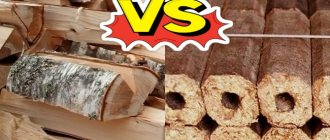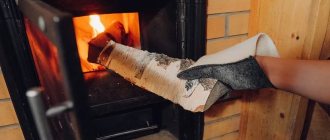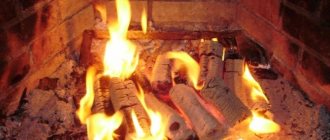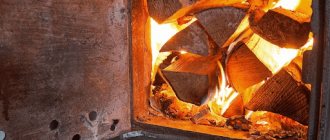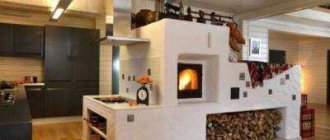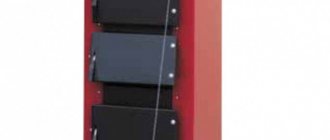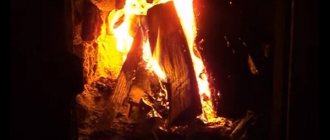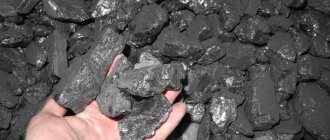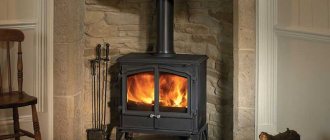Fuel briquettes are a modern alternative to conventional firewood or coal. They are compressed waste from the woodworking industry: sawdust, chips, shavings. Some types of briquette fuel are made from straw, sunflower husks, pine needles and other similar materials. The crushed waste is dried and pressed into a form convenient for use. Otherwise they are called Eurowood, since they were originally developed in Germany. This type of fuel has high potential and can completely replace firewood.
What is better - firewood or fuel briquettes?
Now briquette fuel, or pellets, is quickly gaining popularity among owners of cottages, dachas, and country houses. And this is not surprising, because, unlike ordinary firewood, briquettes do not require splitting, and during the combustion process they do not produce acrid smoke, ash and dirt. In addition, the efficiency of briquette fuel is five times greater than that of traditional fuels.
Briquette fuel burns twice as long as regular logs. This is preferable for stoves with a long burning period. And in stoves or fireplaces with a fast combustion cycle, it is better to use wood, given their high heat output.
Which firewood to choose for heating
Firstly, the firewood must be dry.
Table of wood moisture percentage depending on drying time
| Drying time | Log (chopped), % | Log (not chopped), % |
| Freshly cut | 75 | 78 |
| 3 months | 48 | 62 |
| 6 months | 37 | 46 |
| 9 months | 33 | 38 |
| 1 year | 26 | 35 |
| 1.5 years | 18 | 27 |
| 2 years | 16 | 24 |
| 2.5 years | 15 | 24 |
The most suitable wood for heating is hardwood (beech, oak, acacia, ash, alder and all types of fruit trees), as well as maple and chestnut. Soft woods , such as linden, birch, aspen, poplar, burn much faster, producing more ash and the heat cools quickly. Hardwood firewood produces fewer odors and burns with an open fire until ash forms.
Softwoods burn brightly and quickly, with frequent crackling and hissing (due to resin crystals). Resinous firewood contributes to the formation of large amounts of soot and soot . If you constantly use firewood with a moisture content of more than 20%, as well as coniferous wood, the risk of soot igniting in the chimney increases through the formation of creosote sediment, which easily ignites. It should be removed. An important sign of the quality of firewood is its calorie content, that is, the amount of heat reduced to MJ that is created when burning 1 kg of fuel. It is recommended to use rhizomes and the lower part of the trunk, since they have a higher calorie content than the upper part, and even more so the branches.
Depending on the type of wood, firewood will have different calorie content - the ability to release a particular amount of heat.
Calorie table for different types of wood
| Wood type | Density, kg/m3 | Calorie content, MJ/kg |
| Christmas tree | 400 | 13,8 |
| Poplar | 370 | 13,4 |
| Birch | 490 | 14,2 |
| Alder | 480 | 14,1 |
| Beech | 540 | 14,8 |
| Acacia | 520 | 14,9 |
| Oak | 520 | 16,5 |
| Fruit trees | 480 | 14,1 |
The table shows that the density of wood of different species is directly proportional to their calorie content. It is believed that 1 kg of dry firewood provides an average of 3200 to 3600 kcal. After burning wood, ash is formed in the boiler chambers, which is an excellent fertilizer for your plants.
Solid fuel heating boilers are designed to burn wood with a moisture content of up to 20%. For boilers, the optimal fuel is dry chopped firewood with a diameter of 120-150 mm, aged for 2 years, with a humidity of 12-20%, up to 1000 mm in length, with a calorific value of 15-17 MJ/kg . The usable energy content of wood decreases significantly with increasing water content. As moisture increases, the load on the chimney, chimney, and ceramic lining of the boiler increases. When burning wood with high humidity, the boiler may not reach the specified power, there is a high probability of condensation formation both in the boiler and in the chimney, as well as destruction of ceramic inserts (boiler lining).
Burning wood with a moisture content higher than 40% and less than 12% is prohibited
For example:
Wood with 20% moisture has a thermal value of 4 kW, hour, per 1 kg of wood.
Wood with 60% humidity has a thermal value of 1.5 kW, hour, per 1 kg of wood
| Breed | kW/kg | 20% humidity kW/m3 | 50% humidity kW/m3 |
| Beech | 4,2 | 2200 | 1930 |
| Oak | 4,2 | 2100 | 1850 |
| Ash | 4,2 | 2100 | 1850 |
| Birch | 4,3 | 1900 | 1650 |
| Maple | 4,1 | 1900 | 1650 |
| Alder | 4,1 | 1500 | 1300 |
| Poplar | 4,1 | 1400 | 1230 |
| Pine | 4,4 | 1700 | 1500 |
| Larch | 4,4 | 1700 | 1500 |
At 50% humidity, the boiler power decreases by 2-3 times, and fuel consumption increases by 2-2.5 times:
Which fuel is more profitable?
When choosing between briquettes and regular firewood, you should take into account the cost of these types of fuel.
For example, in Moscow, one cubic meter of briquette fuel varies within 6 thousand rubles, and for the same volume of wood you will have to pay approximately 3 thousand rubles. However, in the total mass of logs, as a rule, about a third can be low-quality, raw products. Considering that the heat transfer from burning logs is much lower than from briquettes, the benefits of using briquette fuel are obvious.
These calculations are approximate and are not suitable, for example, for regions where a truckload of firewood can be bought for very little money.
Combustion chamber of a coal furnace
Hard coal has better parameters than brown coal. Its calorific value is 6000±500 kcal/kg. Various varieties are distinguished by the degree of ash content and the amount of volatile substances:
- Coal (low ash, low in volatile substances).
- Gas (low ash, rich in volatile substances).
- Shale (forms a lot of ash, has a lot of moisture).
For use in home stoves, the most convenient type of coal is hard coal. It stores well and does not spontaneously combust. It is enough to simply pour it in the barn on the floor or in drawers. But firewood is used to ignite it, since it takes a long time to light up on its own. It is necessary to say something about the design of the combustion chamber. It must be designed to use this type of fuel. Its device is distinguished by an additional channel for supplying secondary air. Also, its role can be played by a blower or a half-open flap of the combustion chamber.
Which fuel briquettes burn better and last longer?
Euro firewood differs from each other only in shape and material of manufacture. Wood briquettes made from sawdust burn better and longer than others, if we talk about the material used.
There are three main forms of fuel briquettes, which will also have different calorific values:
- Roof - produced in the form of bricks, have a small size and low density - 0.7 - 0.8 grams per cubic centimeter. They are easy to use and have high calorific value. This is an average price-quality ratio;
- Pini-kei - the cross-sectional shape resembles a square or hexagon with a through hole for better air movement and combustion. They have a high density of 1.08 to 1.4 grams per cubic centimeter. Such products are characterized by special surface firing, due to which these briquettes are more durable, and they burn longer and better. Pini-key briquettes are number one among analogues;
- Nestro is produced in the shape of a cylinder and has an average density of 1 to 1.15 grams per cubic centimeter. Such briquettes have a low cost and, accordingly, burn out faster than the analogues described above;
Is it necessary to heat with peat?
Peat is briquetted because it has a sufficient amount of moisture before drying, and after this procedure it crumbles. Thanks to compaction, a similar difficulty is eliminated, but this will not be the reason for reducing the formation of ash in large quantities during the combustion process. This disadvantage is considered significant when using peat. Cleaning and maintaining the stove are considered labor-intensive processes. With a combustion chamber containing this flammable substance, a similar task becomes several times more difficult, because a constant operation of removing ash from the grate and ash pan is required, during which these harmful particles try to scatter throughout the living space.
What are briquettes for heating made of?
When choosing briquette fuel, it is important to pay attention to the material used to make the product. In the production of pellets, waste from the wood processing industry is most often used. However, products made using waste from plywood mills should be avoided. Such briquettes may contain formaldehyde resins and their combustion cannot be considered environmentally safe. Agriculture also has a huge supply of processed products, which successfully serve as raw materials for the production of pellets.
The raw materials used affect not only the final cost of the product, but also the calorific value of the briquette, the amount of soot emitted, ash content, as well as the quality and completeness of combustion.
Excellent of the best: fruity, birch and linden
This list is also supplemented by fruit trees: pear, apple tree. They emit a good smell and burn well, but it is difficult to kindle with any hard logs. Birch and linden are considered excellent for the combustion chamber of a furnace. Birch produces a small amount of moisture even in its raw form. Logs can be placed in the combustion chamber without drying; they will still give off great heat and will smolder for a long time.
Linden is valued for its healing qualities. If you heat the stove with linden wood, there will be a healing climate in the house or bathhouse. Linden burns slowly, with good heat transfer. Likewise, hardwoods are excellent varieties, and among these are birch and linden.
Softwood
Soft varieties of wood melt quickly, but require drying to a residual moisture of 20% and good preservation. These include coniferous varieties. Cons: a decent amount of resins, high sparkle (with an open combustion chamber, the fire hazard increases). Mainly popular types are used: pine and spruce. They are easy to chop and saw, the cost of purchasing this firewood is not high.
Briquette composition
- Wood shavings. Briquettes made from it have a good specific heat of combustion, but leave behind quite a lot of ash, similar to the wood from which they are made;
- Sunflower husk. Such briquettes provide the highest calorific value due to the oil they contain, which has good energy potential. However, it must be taken into account that briquettes made from sunflower seeds more intensively pollute the chimney with soot;
- Straw. It is considered a good raw material for pellets because it has low cost, good heat transfer and average ash content;
- Tyrsa. Briquettes made from this perennial plant burn well. The specific heat of their combustion is higher than that of straw pellets, and they leave less ash;
- Rice husk. The most budget-friendly option for producing fuel briquettes, which have low calorific value and high ash content. But after processing rice, a lot of husk remains, so this type of raw material should be used and is an alternative.
Popular types of wood briquettes
We have already talked about the production of fuel briquettes for heating boilers and furnaces, as well as their key advantages and disadvantages. It remains to figure out what types of briquettes are presented on the domestic market.
Fuel briquettes RUF
This fuel resembles white or wood-colored bricks in appearance (the shade varies widely).
RUF briquettes are made from dry sawdust by pressing under high pressure. As a result, Euro-firewood is born, which can be used in any type of stove. Their distinctive feature is the inscription RUF, embossed on both sides. RUF fuel briquettes for heating stoves are characterized by the release of a large amount of heat - they are almost one and a half times more profitable than firewood . They are easy to load combustion chambers and store them in stacks. Pressed bars are not afraid of moisture, but there is also no need to expose them to direct water. This fuel is supplied by many manufacturers - a typical example is. By the way, it also sells many other types of solid fuel.
Eurobriquettes PINI KAY
An interesting feature of these Eurobriquettes is their unusual shape - they resemble square pencils from which someone has taken the lead.
That's why they are called "pencils". In order for it to burn with the release of a large amount of heat, a hole is made in it, increasing the draft. The “pencils” themselves look dark, as they were fired. This procedure makes them more durable and removes excess moisture. The disadvantage of PINI KAY fuel briquettes for heating stoves is that they are more expensive than firewood and even more expensive than any other types of fuel. But they burn well, releasing a large amount of heat. They are also convenient to transport and store. Thanks to their shape, they are ideal for lighting fireplaces. Some people take them with them into the wild to use PINI KAY bars instead of wood for a fire.
Simple cylindrical briquettes
The simplest fuel briquettes for heating stoves are also on sale - in the form of cylinders. They are made from pressed sawdust and small wood waste. All this is pressed under slight pressure using a non-toxic adhesive base, after which the finished bars are sent to consumers. This fuel is cheap, but has one distinct drawback - low strength. It easily disintegrates and crumbles and does not withstand exposure to moisture.
Fuel briquettes from coal and peat
Peat and coal fuel briquettes for heating stoves are made from peat and coal, respectively. The starting materials are formed into small cylinders. The fuel can be used to light stoves and solid fuel boilers. Coal products give a high combustion temperature, but are characterized by high ash content .
As for peat fuel, it is ideally suited for long-burning stoves, but it also produces a lot of ash. If you have a stove that needs something to heat, we recommend that you use PINI KAY or RUF fuel briquettes. They are distinguished by their convenience and high calorific value, form a minimum of ash and provide long-lasting combustion.
Fuel briquettes - pros and cons
What are the advantages of fuel briquettes:
- Ease of storage - Euro firewood is stacked in even stacks, thanks to the same shape;
- Longer burning time compared to conventional firewood;
- Uniform and soft burning, more like smoldering, without crackling or shooting embers;
- Low labor costs for further cleaning and maintenance of the furnace due to the release of less ash and soot;
- Environmentally friendly use - briquettes burn 97-99%, almost without forming resins;
The use of fuel briquettes does not come without certain disadvantages:
- Briquette fuel has a limited shelf life and use. As a rule, it ranges from one year to three years from the date of manufacture;
- The cost of purchasing pellets may be more significant than purchasing firewood. It all depends on the manufacturer or region of residence;
- Some types of briquettes have low moisture resistance;
Fire wood stoves
Wood-burning stoves provide efficient heating of residential and non-residential premises. They are presented in many models, differing in their technical characteristics and design. They use the most ordinary firewood as fuel - they can be purchased by the truckload. But this fuel cannot be called modern and efficient. And today it has been replaced by fuel briquettes for heating stoves.
To clarify, let's look at the main disadvantages of traditional wood fuel:
Ordinary firewood must first be chopped and then placed in neat woodpiles. This is a very labor-intensive and time-consuming process.
- It is inconvenient to stack firewood in neat stacks - if they are the same size and format, then this is not so bad. But if some logs are thin, while others are thick, and even knotty, then the masonry will be crooked and oblique (although a lot here depends on the “curvature” of the hands);
- Firewood needs to be split - it often comes in the form of round logs that require chopping. Swinging an ax in cold weather is a dubious pleasure (although useful);
- Firewood is often damp - seeking for their own profit, lumberjacks sell the wood in a raw state, without first drying it. Compared to almost dry fuel briquettes for heating stoves, they will not be easy to light;
- Low calorific value - a cubic meter of firewood produces less heat than the same wood briquettes of the same volume ;
- Firewood produces a large amount of ash - the same wood briquettes practically do not clog the stoves;
- Wood burns with clicking and crackling sounds, burns unevenly, clearly inferior to briquettes in this regard.
Firewood is the most common and cheapest solid fuel for heating stoves and boilers. But fuel briquettes are superior to them due to their convenience and high calorific value.
How to properly heat a stove with briquettes
When igniting the stove and firing it, you should adhere to the following recommendations. First, the stove must be cleaned of the remnants of the previous combustion. Then a small amount of paper or dry wood chips is placed on the grate. Briquettes are laid loosely on top of the paper if quick combustion is needed. If prolonged burning is required, fuel briquettes should be placed closer to each other. After this, you need to set fire to the paper or wood chips. The most convenient way to do this is with a gas burner. Then you should wait until at least one briquette begins to smolder. And only after this you need to close the stove vent. It is important here to prevent rapid combustion; the briquettes should smolder. Thus, their potential will be revealed gradually and evenly.
A little advice - to reduce soot settling in the chimney, you need to throw a pinch of salt on the pellets or firewood before lighting.
Summarizing the above, we can say that fuel briquettes are an excellent environmentally friendly replacement for firewood and coal. To choose quality products, when purchasing, you should read the test report, which will indicate the main characteristics of the briquette fuel.
What if this doesn't help?
Even when laid correctly, briquettes may not live up to expectations: they burn too quickly and do not provide enough heat. Such situations occur rarely and are mainly associated with:
- The quality of specific briquettes. Try analogues from other manufacturers; you may have stumbled upon low-quality products with a large number of impurities.
- Feature of the oven. Not all designs work well with briquettes, which is why they burn out too quickly and are inferior to conventional firewood in terms of heat production.
Yes, briquettes can easily replace firewood and will be easier to use, but in practice their effectiveness depends on a number of factors. They cannot always reveal themselves 100% and show those beautiful numbers that manufacturers lure with. Therefore, we recommend that you first simply check the briquettes with your stove, especially since for this you do not have to buy a ton of briquettes at once, one package will be enough.
Most modern stoves do not have problems loading briquettes, for example, the Butakov stove
Biofireplace
Biofireplace belongs to modern types of heating systems. The peculiarity of this type is that it does not need a chimney or any hood, even with a real flame in the firebox.
The main part of the biofireplace is a block into which ethanol is poured. Such fuel does not emit any soot or soot during combustion. During combustion, there are no unpleasant odors due to the fact that carbon dioxide and water vapor are combustion products.
Such fireplaces are used only for decorative purposes, so their productivity is zero.
Specifics of furnaces using coal
The vast majority of the real models of stoves that we remember from our grandparents were adapted for the use of wood and coal. This smoothing of the structure was carried out precisely because it was difficult to predict what would have to be used to heat the stove in each specific season. But, if you approach the construction work of the furnace in detail, then such options should vary.
The temperature inside the combustion chamber when coal is ignited is much higher than when wood is ignited. This results in the walls of the iron combustion chamber being enlarged using much thicker sheets. The combustion volume becomes larger due to the lower placement of the grate. The ash pit should be built to be larger in volume, since the amount of ash during coal operation is much greater than that of firewood.
Storage rules
Manufacturers recommend storing fuel briquettes under certain conditions:
- temperature from 5 to 400C;
- relative air humidity 40-80%;
- away from sources of open flame and away from direct sunlight.
Briquettes must be reliably protected from acid-base environments and moisture. The shelf life of fuel briquettes is from 3 to 5 years.
Fuel in pellets
Fireplaces equipped with a firebox for heating with pellets are equipped with a burner that is shaped like a bowl with holes in the bottom and walls. Fuel is supplied into this bowl in portions, and air is forced from below. This fuel has a calorific value of 4400 kcal/kg. It is possible to control these fireplaces remotely because the combustion process is automatically regulated.
The design of fireplaces operating on this type of fuel is simplified in that a chimney is not required, and a hood is installed instead. They can be placed on any floors.
The disadvantages of such fireplaces include cost. A fireplace designed for 10 kW of power will cost about 50,000 rubles.
Food for thought and recommendations
We do not persuade anyone to give up wood heating in favor of briquettes. The purpose of the publication is to convey useful information, help homeowners save money and gain comfort. What conclusions emerge from the comparison:
- The attractiveness of firewood is its low price. The main thing is that they are not too raw.
- The previous section indicates the cost of firewood delivered in the form of logs. The latter need to be sawn into logs and split into logs. If the household does not have a chain saw, you will have to pay extra for sawing.
- Due to their low density, logs take up more space than briquettes.
- Pressed waste burns much longer than wood and gives off more heat. The number of visits to the boiler room will decrease.
It is better to heat homemade stoves with wood or put a small amount of briquettes
An important nuance. High-calorie fuel briquettes pose a danger to homemade stoves. When the firebox is fully loaded and the chimney is open, the steel body of the stove is often deformed from the effects of high combustion temperatures.
Pressed products are not flawless. Fuel from agro-industrial waste contains vegetable oil, which settles on the walls of the chimney in the form of soot, and peat leaves ash. To find the optimal solution and clearly select briquettes for a stove, boiler or fireplace, take part of the weekend and conduct a similar experiment with a variety of fuels. Combine “bricks” with firewood, watch the results and count the money - this is the sure way to economical heating.
Questions and answers
Do fuel briquettes contain binding components harmful to human health?
No binding components are used in the production of fuel briquettes. The strength of the products is ensured by the ligin contained in wood and plant materials. Under the influence of high temperatures and pressure, it melts and does not pose a danger to human health.
How long does Eurowood burn?
The duration of burning of Eurowood depends on the conditions in which this process takes place. When burning briquettes with a constant supply of oxygen, the process can last approximately 0.5-1.5 hours, without oxygen - 4 hours.
What is the weight of pini-kei fuel briquettes?
With a density of 1.08-1.36 g/cm3, one cubic meter of fuel briquettes of this type can weigh 1080-1360 kg. This is significantly more than ordinary firewood. At natural humidity of 20%, a cubic meter of oak weighs 800 kg, birch - 750 kg and pine - 520 kg.
Which fuel briquettes are best to choose for heating a bath?
For sauna stoves, briquettes of the RUF type are most often used.
What volume of firewood can replace 1 ton of fuel briquettes?
One ton of fuel briquettes can replace 4-6 m3 of ordinary firewood.
